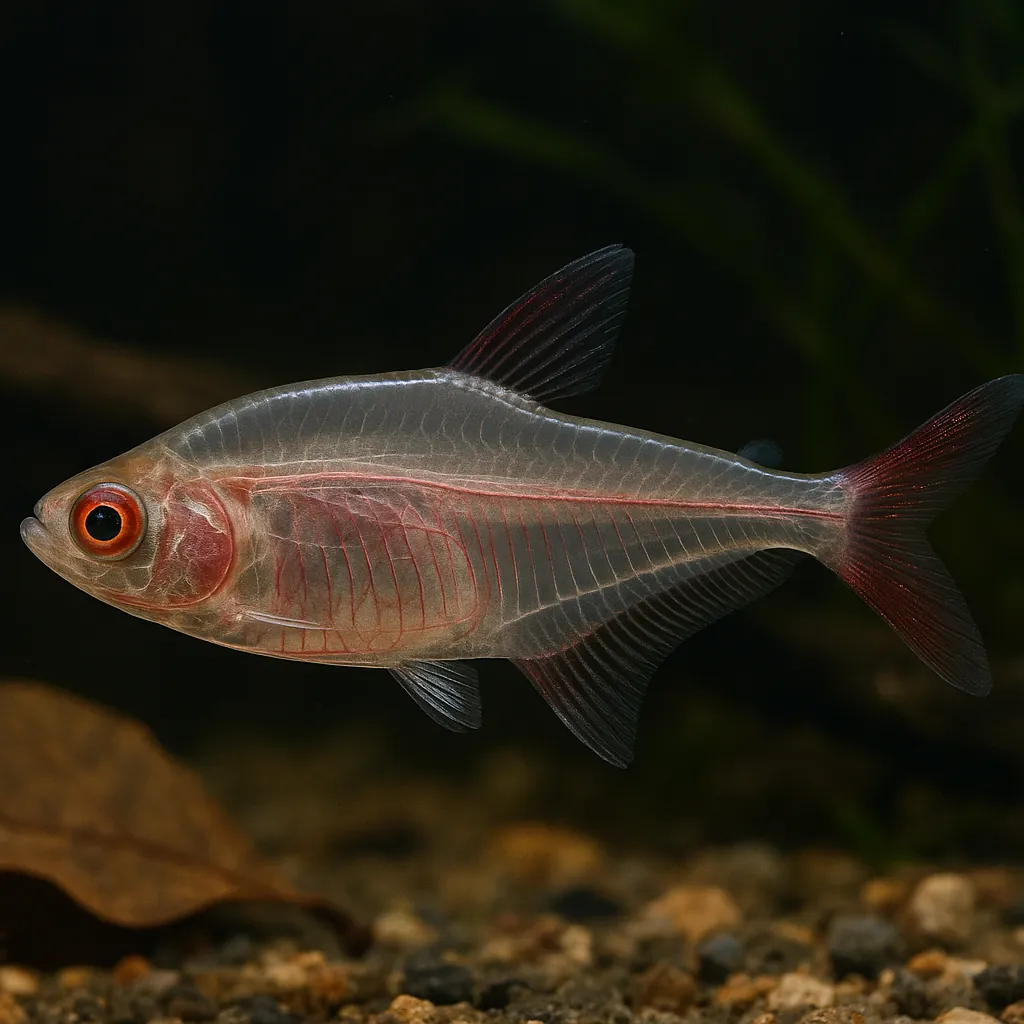
Glass bloodfish
The Glass Bloodfin Tetra (*Prionobrama filigera*) is a captivating freshwater fish renowned for its translucent body and vibrant red fins. This unique appearance makes it a standout addition to any aquarium. Native to the Amazon River basin in South America, the Glass Bloodfin Tetra is appreciated by aquarists for its peaceful nature and relatively straightforward care requirements, making it suitable for both novice and experienced fishkeepers.
**What makes the Glass Bloodfin Tetra a popular choice among aquarists?**
Its striking transparency combined with the vivid red coloration of its fins offers a visually appealing contrast, enhancing the aesthetic of community tanks.
**Is the Glass Bloodfin Tetra suitable for beginners?**
Yes, due to its hardy nature and ease of care, it is an excellent choice for those new to fishkeeping.
**Does this species require any special care considerations?**
While generally hardy, maintaining stable water conditions and keeping them in groups are essential for their well-being.
Care and Environment
Providing an optimal environment is crucial for the health and happiness of Glass Bloodfin Tetras. **What is the minimum tank size for a single Glass Bloodfin Tetra?** A minimum of 75 liters is recommended to accommodate their active nature and schooling behavior. **What are the ideal water parameters for this species?** Maintain a temperature between 22°C and 28°C, pH levels from 6.0 to 8.0, and water hardness between 5 to 15 dGH. **How should the tank be decorated to suit their needs?** Incorporate live plants like Java moss, Amazon sword, or Vallisneria to provide hiding spots and mimic their natural habitat. **What type of filtration and lighting is best?** Use a reliable filtration system to ensure clean, well-oxygenated water with gentle flow. Subdued lighting is preferred to replicate their native environment. **What should their diet consist of?** Offer a varied diet including high-quality flake foods, supplemented with live or frozen foods like daphnia and bloodworms to meet their nutritional needs. **Are there any specific challenges in caring for Glass Bloodfin Tetras?** They are sensitive to poor water quality, so regular maintenance and monitoring are essential to prevent stress and disease.Origin and Habitat
The Glass Bloodfin Tetra hails from the Amazon River basin in South America, thriving in slow-moving rivers and floodplains. These environments are characterized by warm temperatures, soft to moderately hard water, and abundant vegetation. The natural habitat provides ample hiding spots and a diverse diet, which should be emulated in captivity to ensure their well-being. **Where is the Glass Bloodfin Tetra naturally found?** It is native to the Amazon River basin in South America. **What type of environments do they inhabit in the wild?** They thrive in slow-moving rivers and floodplains with abundant vegetation. **How can their natural habitat be replicated in an aquarium?** By maintaining warm, soft to moderately hard water with plenty of live plants and hiding spots.Temperament and Compatibility
Glass Bloodfin Tetras are peaceful, schooling fish that thrive in groups of at least six. Their non-aggressive nature makes them excellent candidates for community tanks. **Are Glass Bloodfin Tetras aggressive?** No, they are peaceful and do well with other non-aggressive species. **What are suitable tank mates for this species?** Compatible companions include other peaceful community fish such as tetras, rasboras, danios, and small catfish species. **How can a harmonious tank community be achieved?** By selecting similarly sized, peaceful fish and providing ample space and hiding spots to reduce stress.Interesting Facts
The Glass Bloodfin Tetra's transparent body serves as a natural camouflage, helping it evade predators in the wild. This species is known for its active schooling behavior, often moving in unison, which adds dynamic movement to aquariums. Breeding them in captivity can be challenging, as they are egg scatterers and may consume their own eggs if not promptly removed. **Why is the Glass Bloodfin Tetra's body transparent?** The transparency acts as camouflage, making it harder for predators to spot them. **What is unique about their schooling behavior?** They exhibit synchronized swimming, creating a mesmerizing display in aquariums. **Is breeding Glass Bloodfin Tetras in captivity easy?** Breeding can be challenging due to their egg-scattering nature and tendency to eat their own eggs.Sources
All information in this article has been gathered from the following reputable sources:Overview
Recommended Tank Size 29.9 Gallons (. for groups of 6 or more) |
Minimum Group Size 6 |
Minimum Tank Volume 19.8 Gallons |
Maximum Adult Length 2 inches |
Average Adult Length 1.6 inches |
Shoaling (6+ required) Yes |
Preferred Water Type Freshwater, soft to moderately hard, slightly acidic to neutral |
Temperature Range (°C) 22–28 |
pH Range 6.0–8.0 |
Water Hardness (dGH) 5–15 |
Typical Lifespan (years) 5 years |